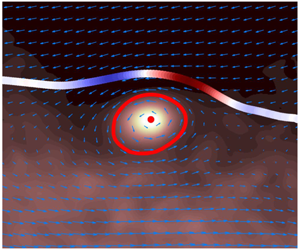Crossref Citations
This article has been cited by the following publications. This list is generated based on data provided by
Crossref.
Neamtu-Halic, Marius M.
Krug, Dominik
Mollicone, Jean-Paul
van Reeuwijk, Maarten
Haller, George
and
Holzner, Markus
2020.
Connecting the time evolution of the turbulence interface to coherent structures – CORRIGENDUM.
Journal of Fluid Mechanics,
Vol. 899,
Issue. ,
van Reeuwijk, Maarten
Vassilicos, J. Christos
and
Craske, John
2021.
Unified description of turbulent entrainment.
Journal of Fluid Mechanics,
Vol. 908,
Issue. ,
Neamtu-Halic, M. M.
Mollicone, J.-P.
van Reeuwijk, M.
and
Holzner, M.
2021.
Role of vortical structures for enstrophy and scalar transport in flows with and without stable stratification.
Journal of Turbulence,
Vol. 22,
Issue. 7,
p.
393.
Long, Yanguang
Wu, Di
and
Wang, Jinjun
2021.
A novel and robust method for the turbulent/non-turbulent interface detection.
Experiments in Fluids,
Vol. 62,
Issue. 7,
Jiang, X.Y.
Gu, D.W.
Lee, C.B.
Smith, C.R.
and
Linden, P.F.
2021.
A metamorphosis of three-dimensional wave structure in transitional and turbulent boundary layers.
Journal of Fluid Mechanics,
Vol. 914,
Issue. ,
Blakeley, Brandon C.
Olson, Britton J.
and
Riley, James J.
2022.
Self-similarity of scalar isosurface area density in a temporal mixing layer.
Journal of Fluid Mechanics,
Vol. 951,
Issue. ,
Huang, Chenyang
Borthwick, Alistair G.L.
and
Lin, Zhiliang
2022.
Lagrangian coherent structures in flow past a backward-facing step.
Journal of Fluid Mechanics,
Vol. 947,
Issue. ,
Long, Yanguang
Wang, Jiangsheng
and
Wang, Jinjun
2022.
“Turbulent/non-turbulent interface” in a low-Reynolds-number transitional boundary layer over a multi-element airfoil.
Physics of Fluids,
Vol. 34,
Issue. 10,
Long, Yanguang
Wang, Jinjun
and
Pan, Chong
2022.
Universal modulations of large-scale motions on entrainment of turbulent boundary layers.
Journal of Fluid Mechanics,
Vol. 941,
Issue. ,
Khan, Jalil ul Rehman
and
Rao, Samrat
2023.
Properties of the turbulent/non-turbulent layer of a turbulent Boussinesq plume: A study using direct numerical simulation.
Physics of Fluids,
Vol. 35,
Issue. 5,
Salinas, Jorge S.
Balachandar, S.
Zúñiga, Santiago L.
Shringarpure, M.
Fedele, J.
Hoyal, D.
and
Cantero, M. I.
2023.
On the definition, evolution, and properties of the outer edge of gravity currents: A direct-numerical and large-eddy simulation study.
Physics of Fluids,
Vol. 35,
Issue. 1,
Blakeley, Brandon C.
Olson, Britton J.
and
Riley, James J.
2023.
On the evolution of scalar iso-surface area density in a turbulent mixing layer.
Journal of Fluid Mechanics,
Vol. 966,
Issue. ,
Zhang, Xinxian
Watanabe, Tomoaki
and
Nagata, Koji
2023.
Reynolds number dependence of the turbulent/non-turbulent interface in temporally developing turbulent boundary layers.
Journal of Fluid Mechanics,
Vol. 964,
Issue. ,
Brizzolara, Stefano
Mollicone, Jean-Paul
van Reeuwijk, Maarten
and
Holzner, Markus
2023.
Entrainment at multi-scales in shear-dominated and Rayleigh–Taylor turbulence.
European Journal of Mechanics - B/Fluids,
Vol. 101,
Issue. ,
p.
294.
Chen, Letian
Fan, Ziye
Tang, Zhanqi
Wang, Xuan
Shi, Dewei
and
Jiang, Nan
2023.
Outer-layer coherent structures from the turbulent/non-turbulent interface perspective at moderate Reynolds number.
Experimental Thermal and Fluid Science,
Vol. 140,
Issue. ,
p.
110760.
Xu, Congyi
and
Wang, Jinjun
2024.
Vortex ring breakdown dominating the entrainment of a synthetic jet.
Journal of Fluid Mechanics,
Vol. 980,
Issue. ,
Chen, Letian
Tang, Zhanqi
Fan, Ziye
and
Jiang, Nan
2024.
Outer-layer self-similarity of the turbulent boundary layer based on the turbulent/non-turbulent interface.
Physical Review Fluids,
Vol. 9,
Issue. 3,
Watanabe, Tomoaki
2024.
Efficient enhancement of turbulent entrainment by small-scale shear instability.
Journal of Fluid Mechanics,
Vol. 988,
Issue. ,
Li, Sicheng
and
Wang, Jinjun
2024.
Entrainment of the shear layer separated from a wall-mounted fence.
Journal of Fluid Mechanics,
Vol. 999,
Issue. ,
Xie, Yuanliang
Zhang, Xinxian
Xiong, Xue-Lu
and
Zhou, Yi
2024.
Temporal evolution of the turbulence interface of a turbulent plane jet.
Journal of Fluid Mechanics,
Vol. 1001,
Issue. ,
